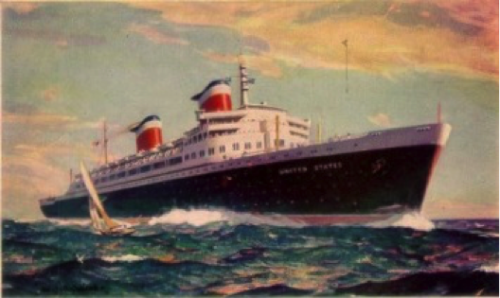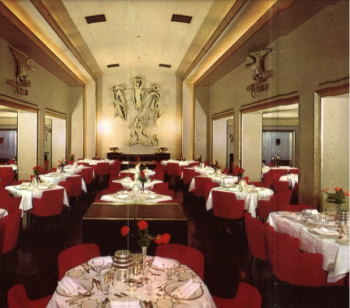Editor’s note: The veil between the worlds is very thin this morning, and my pal Marlow hit me right between the running lights this morning. We both can feel it; something in the air, or maybe the vibrations of the earth beneath our feet. I have felt this way before- a sense of foreboding that I cannot explain, but real as day. Like the summer of 2001…
Marlow and I have shared some times down through the years: life birth death and divorce. Ultimately infinity- but not just yet.
I have dragged you, Gentle Reader, to the gray and stormy Atlantic and the Wine Dark Sea of the Mediterranean in a distant year. It is filled with the minutia of life afloat and ashore. That is the life we lived in men of war. But there was another kind of life upon the waves, not a bellicose one, but a means of transit that was frankly tinged with the miraculous. Marlow nailed this one. He describes the way things were in a ship built the same year I was, and a way of life as incredible as a newsreel of the luxury of crossing the oceans by Zeppelin.
Join Marlow for the last crossing of the SS United States:
Vic
Crossings
From Marlow’s Life and Island Times
Forty-seven years ago, young Marlow crossed the Atlantic on the SS United States. He sailed to his sophomore year at a French university. He and his fellow students hung out in the first class lounge each and every day. They were not interlopers. An alum of their alma mater was a board member of the Cunard Lines. Through his largesse were they able to acquire first class accommodations at steerage prices.

Postcard of Cunard Lines SS United States
She was a speed demon, setting the still existing time record for easterly crossing. Why all this speed? Her construction was underwritten by the U.S. government (two thirds of her cost would be half a billion in today’s dollars) to allow conversion to a troopship capable of carrying over 15,000 troops across the pond to bloody Europe in little more three days, Marlow was fortunate to sail on her last regularly scheduled crossing.
Since she was dual use, the designers of United States used no wood in the ship’s framing, accessories, decorations, or interior surfaces. Fittings, including all furniture and fabrics, were custom made in glass, metal, and spun glass fiber to ensure compliance with fireproofing guidelines set by the U.S. Navy. Specially commissioned artwork included pieces by fourteen artists, including Nathaniel Choate, muralist Austin M. Purves, Jr., and sculptor Gwen Lux. Even the clothes hangers in first class cabins were aluminum. The ballroom’s grand piano was made of fire-resistant wood species—although originally specified in aluminum. It was accepted only after a demonstration in which gasoline was poured upon the wood and ignited, without the wood itself igniting.
When she came into service in 1952, the SS United States was done in the most tasteful luxurious manner befitting her then unipolar power’s namesake. She was stunningly beautiful, sleek, lightweight due to her use of aluminum and capable of sustained 35 knot travel for over 10,000 nautical miles with full provisions for the crew and passengers. Her best fuel efficiency speed was 30 knots making her wake a churning rainbow cauldron at each and every sunset and sunrise. Her top speed was likely close to 45 knots.

SS United States first class lounge and ballroom
There was nothing like the first class lounge as the day waned. Elegant 25 cent cocktails in crystal glasses, monogrammed with the insignia of the Line, listening to the grand piano player playing the standards and the occasional request, playing bridge (or learning to do so poorly, with fellow college students and few non-flying swells from NYC and Philadelphia), and watching the sunset filled three precious hours each afternoon during the five day crossing.
Players drifted away as the sun dipped and dinner bongs were heard, calling away the first and second seatings for the evening meals. It was at this time, when the lounge became empty, immaculate and holy. With show tunes from the 30s playing, it silently transformed itself into a time machine, transporting the few remaining imbibers into the modernist 1930s.
Marlow did not understand the meaning of these moments and the visions he had until decades later. During these clairvoyant minutes he had visions of past and future events. He did not understand this gift. He clearly saw watery homes of steel and coral and children, while intensely feeling alternating sorrow and joy.
On his return voyage in 1969, it was the north Atlantic storm season. The lounge and dining rooms became empty with all but a few passengers becoming seasick and choosing to stay in their cabins as the ship rocked and rolled its way westward. The seas were rough, the skies endlessly grey and the weather decks windy, wet and slippery.
Marlow dined alone at most meals in the elegant first class dining room. The stewards offered him anything he wanted. Steaks, fish, shellfish, wines and desserts of unimaginable pleasure and taste were there for the taking, but he demurred, preferring to eat simply and avoid becoming a gargantuan glutton.

The first-class dining room looking aft toward the sculpture by Gwen Lux, entitled “The Four Freedoms.”
At one breakfast he began pondering the piece by sculptress Gwen Lux at the end of the dining room. Malvar, the head steward, told him upon questioning that its inspiration came from President Roosevelt’s 1941 State of the Union address.
FDR had proposed the idea of four fundamental freedoms that people “everywhere in the world” ought to enjoy: freedom of speech (from our constitution’s first amendment), freedom of worship (from the first amendment), freedom from want and freedom from fear (from FDR’s first inaugural speech). At that time every quadrant of Europe was being consumed by the fascist powers. The vessel he was sailing on was built in response to a third World War where the losses could be double, triple or quadruple those seen in the last Great War.
A Cold War now gripped the world to which Marlow was returning. The United States was undergoing a multipronged domestic revolution that seemingly threatened its very existence. Was a fascist response forthcoming from Washington DC’s new leaders? Was a temptress and corruptor on the scene about to play to our baser fears of fear itself? Time would tell.
As the sun rose in the east, Marlow entered the empty lounge. He chained-smoked Gauloise cigarettes, while waiting for the lounge to brighten each morning with a blue grey tint. The feelings of nine months prior came again; but, they were different, more akin to mourning and loss. Were they a sign of impending cataclysm? The world nearly blew itself up seven years prior and would nearly do so again in 1973 and 1983. They were slightly different this time, more akin to mourning and loss. Were they a sign of impending cataclysm?
Only having experienced the profound bereavement of a daughter’s, parents’ and shipmates losses in the ensuing years that followed do these two crossings’ brief moments begin to make sense.
The small indoor pool of the ship, reserved only for the ship’s luxury travelers, still remains in Marlow’s memory banks as deeply foreboding. Of what, he knows not.

Indoor pool of the SS United States.
The only connected dot amongst all these visions was that of water.
Copyright © 2016 From My Isle Seat
www.vicsocotra.www
